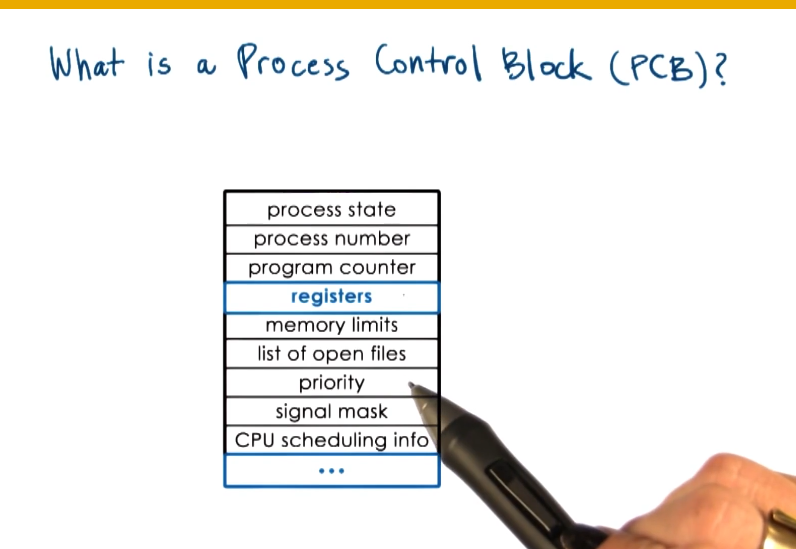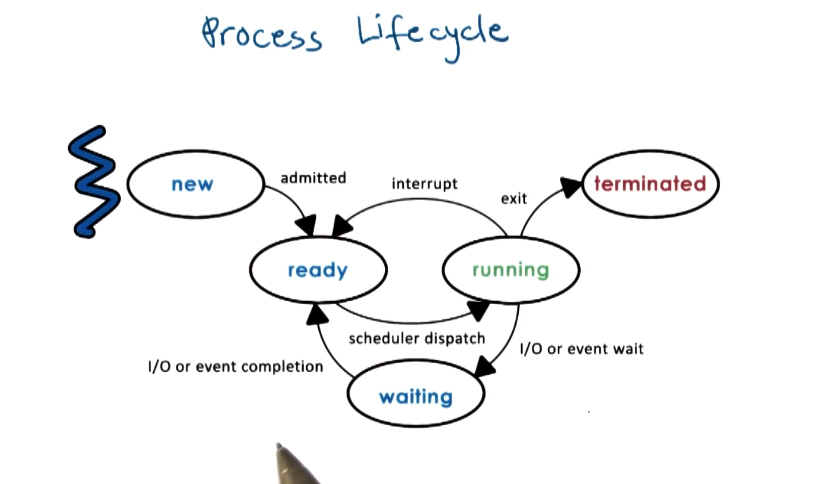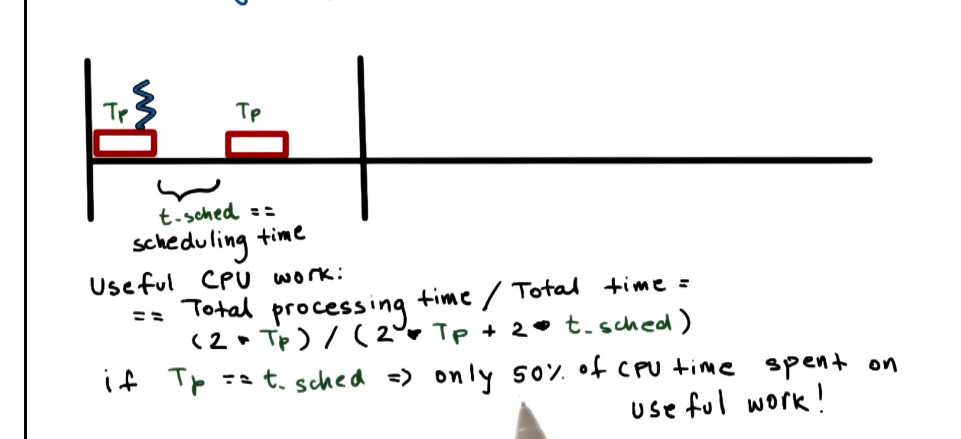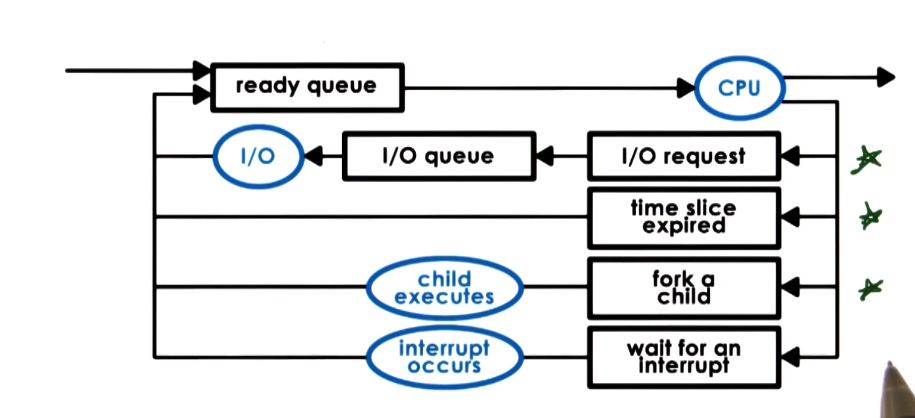GIOS Lecture Notes - Part 2 Lesson 1 - Process and Process Management
What is a Process
- Simple definition - an instance of an executing program. Sometimes called a task or a job.
- OS manages hardware on behalf of applications
- Application == program on disk, flash memory, etc. A static entity.
- Process == state of a program when executing loaded in memory. An active entity
- Execution state of an application
- Same application can be run multiple times, each as its own process
What does Does a Process Look Like
- A process encapsulates all of the state of a running application
- Address space is an OS abstraction to capture all of this state.
- Types of state:
- text and data
- static state when process first loads
- heap
- dynamically created during execution
- stack
- grows and shrinks
- LIFO queue
Process Address Space
- Address space == ‘in memory’ representation of a process
- V0 to Vmax represent the range of virtual addresses used by process
- Called virtual because it does not necessarily need to correspond to physical memory locations
- Physical addresses are locations in physical memory (DRAM)
- Hardware and OS maintain a mapping from physical memory to virtual memory
- Page tables == mapping of virtual to physical addresses
Address Space and Memory Management
- Not all processes require all address space from V0 to VMax
- Parts of virtual address space may not be allocated
- May not be enough physical memory for all state
- OS dynamically decides which portion of which address space will be stored in physical memory, and where.
- Multiple processes may share physical memory
- All such process may have portions of their state swapped out to hard disk, to be brought in if and when needed
- OS may also perform memory access validity checks to ensure that a process has permission to access the specific memory it is trying to
Process Execution State
- How does the OS know what a process is doing?
- Before a process can execute it must be compiled into binary
- OS must know where in a process’ binary instructions it is. This is done with a program counter (PC)
- Kept in a CPU register
- Other registers keep other information about other pieces of state
- Also need a stack pointer, keep track of where the top of the stack is, to track that component of state
- OS maintains a process control block (PCB) to track miscellaneous other peices of state.
What is a Process Control Block
- A PCB is maintained for every process being managed by OS

- PCB is created and initialized when process is created
- Certain fields are updated as relevant peices of state change
- Other fields change too frequently for that, so CPU keeps dedicated register for those, such as PC register.
- OS must collect and save PCB for every process whenever that process is no longer running on the CPU
How is a PCB Used?
- Whenever there is a context switch between processes, state is saved from and loaded to the PCB

What is a Context Switch
- Context switch == switching the CPU from the context of one process to the context of another
- Expensive
- Direct costs: number of cycles for load and store instructions
- Indirect costs: Cold cache and cache misses. Reading multiple levels of cache down, and maybe even out of memory.
- As a result we want to limit frequency of context switching!
Process Lifecycle
- Processes can be in any of a number of states

- Process Creation
- Processes can create new processes, and all processes forked off from the same original parent – init(1) on Unix, ZYGOTE for Android apps
- Some processes will be privileged, boot processes. When a user logs in, a user shell process is created, and new processes are spawned from that shell.
- Two main mechanisms for process creation
- Fork
- copies the parent PCB into new child PCB
- child continues execution at instruction after fork – same PCB means same program counter, so keep counting forward from same spot
- Exec
- replace child image, loads new PCB
- load new program and start from first instruction in that program’s counter
- Often used in combination, to create new child program with fork and then tee up something completely different than parent with exec
Role of the CPU Scheduler
- For CPU to start executing a process, it must be ready
- However, there will often be multiple process in the ready queue. Need to pick the right one to give to CPU next
- A CPU Scheduler determines which one of the currently ready processes will be dispatched to the CPU to start running, and how long it should run for.
- OS must:
- preempt == interrupt currently executing process and save its context
- schedule == run scheduler to choose next process
- dispatch == dispatch process onto CPU and switch into its context
- BE EFFICIENT ABOUT ALL THIS
Length of Process
- How long should a process run for?
- How frequently should we run the scheduler?
- More often we run it, more time we spend dinking around with scheduling instead of doing work


- timeslice == time since Tp allocated to a process on the CPU
- Scheduling Design Decisions
- What are appropriate timeslice values?
- Metrics to choose next process to run?
What about I/O?

Inter Process Communication
- Can processes interact? - Yes! OS Must provide
- These days more and more applications are actually multiple processes
- e.g. web server front end and database backend
- OS goes to great lengths to protect and isolate processes from each other. IPC has to be built around these protections.
- Inter-Process Communication (IPC) Mechanisms:
- Transfer data/info between address spaces
- Maintain protection and isolation
- Provide flexibility and performance
- Message-passing IPC:
- OS provides communication channel, like shared buffer
- Processes write/read messages to/from channel
- Pros
- OS manages the channel and provides APIs
- Cons
- Overhead. Lots of extra reads/writes for communication
- Shared memory IPC:
- OS establishes a shared channel and maps it into each process address space
- Processes directly read/write from this memory
- Pros
- Cons
- Reimplement code to handle all the safe reading/writing from shared memory





